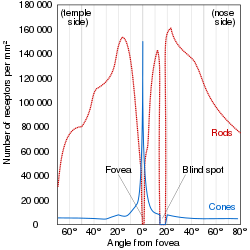Blind spot (vision)
[2] Because there are no cells to detect light on the optic disc, the corresponding part of the field of vision is invisible.Via processes in the brain, the blind spot is interpolated based on surrounding detail and information from the other eye, so it is not normally perceived.At the time it was generally thought that the point at which the optic nerve entered the eye should actually be the most sensitive portion of the retina; however, Mariotte's discovery disproved this theory.[3] It is estimated that once fully adapted to darkness, the rods are 10,000 times more sensitive to light than the cones, making them the primary receptors for night vision.The concentration of cones in the fovea can make a night blind spot in the center of the field of vision.

Blind spot (disambiguation)VertebrateOctopusretinaoctopus eyesoptic nervescotomavisual fieldphotoreceptor cellsoptic discinterpolatedvertebratescephalopod eyesEdme MariotteBias blind spotFilling-inHorizontal eccentricityAcute idiopathic blind spot enlargement syndromeScholarpediaFederal Aviation Administrationpublic domainvisual systemEntoptic phenomenaPhospheneFloaterAfterimageHaidinger's brushPrisoner's cinemaBlue field entoptic phenomenonPurkinje imagesForm constantScintillating scotomaPalinopsiaVisual snowAfterimage on empty shapeCosmic ray visual phenomenaClosed-eye hallucination